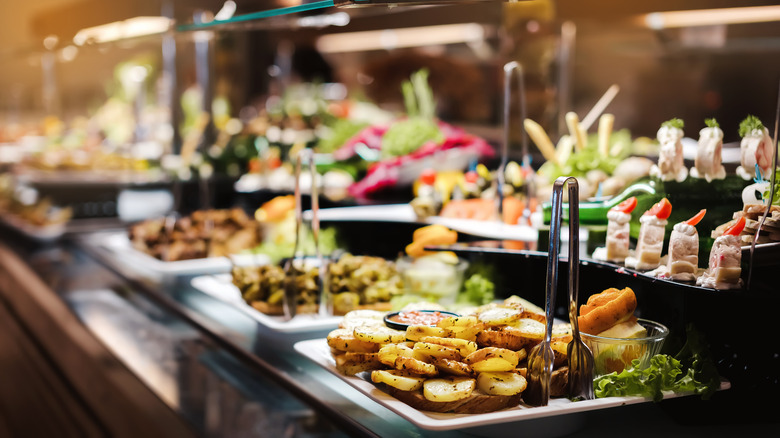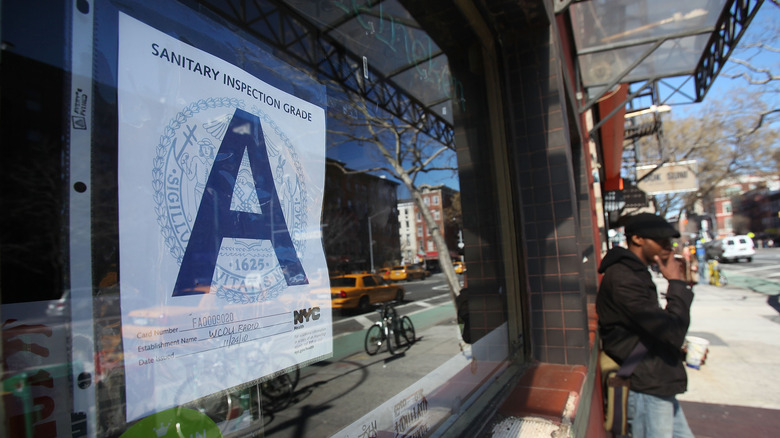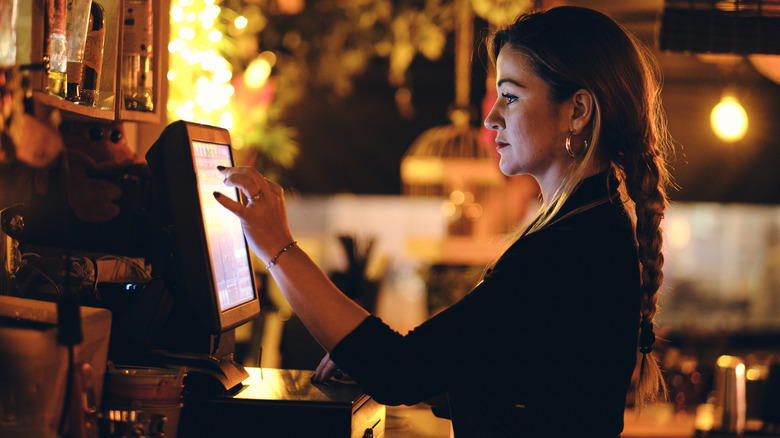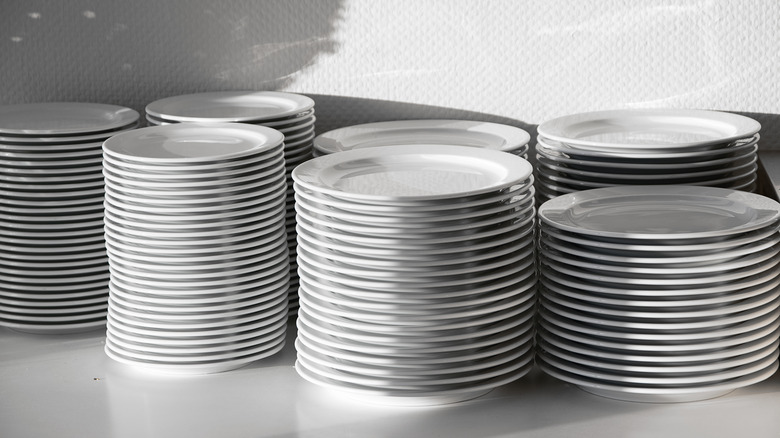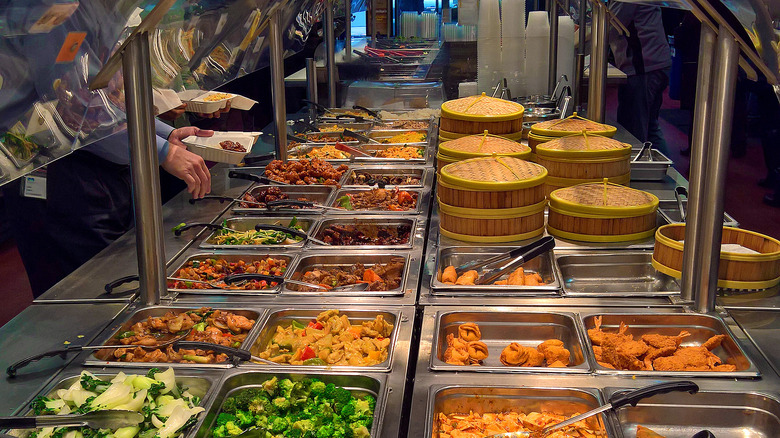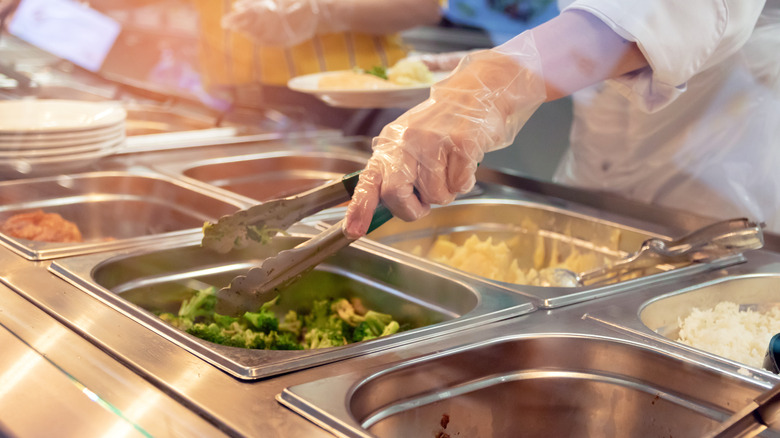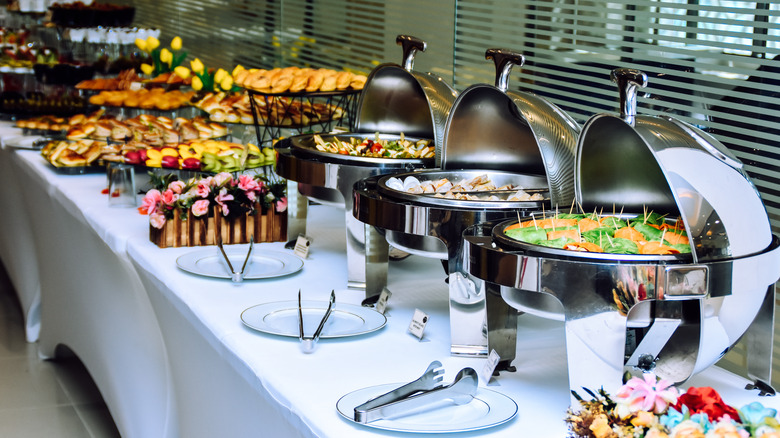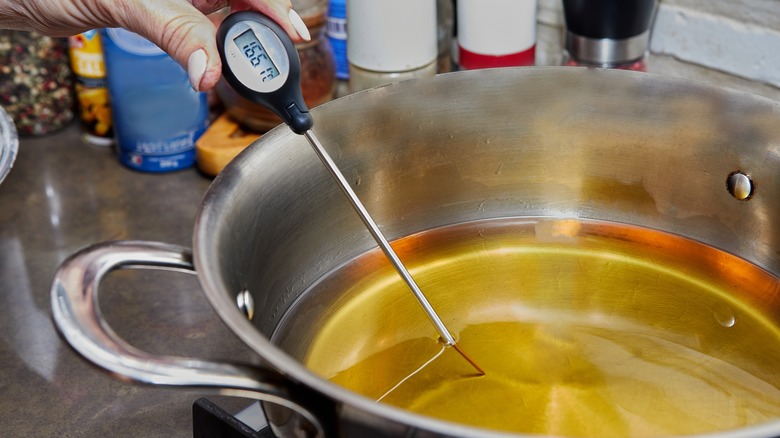The Top 12 Red Flags To Look Out For When Eating At A Buffet
Do you remember the first time you stepped into an all-you-can-eat buffet? If you were young, your eyes likely widened at the sight of a seemingly endless array of food, all at your fingertips, and available for as many servings as your heart desired. Nowadays, however, you may view buffets with a healthy dose of skepticism. You might be leery of any potential germs resting on the serving utensils and wondering just how long those slabs of salmon have been sitting under a heat lamp.
Buffets can be perfectly fine and even great options for your next meal. But before you dive into that salad bar, there are a few things you should be on the lookout for when arriving. From the business operation to the food being served, being hyper-critical of buffets can help you avoid any potential food-borne illness or a dissatisfying meal. While any kind of restaurant can display any number of red flags, buffets in particular have some obvious tell-tale signs that you are getting less than you bargained for.
1. The buffet has very limited hours
Some restaurants operate solely as a buffet, and that should be your first indicator as to whether or not you are in for a positive dining experience. Other restaurants, however, only operate as a buffet during limited hours, such as the weekends. If that is the case, you want to go in with some level of skepticism. That is not to say that the buffet is bad in any way. But it could raise concerns about how the restaurant operates its buffet differently from regular seated hours.
One of the big problems owners have to face is that buffets typically operate on razor-thin margins. To offset costs, buffets may rely on leftover foods from the previous day in order to reduce waste. In fact, sometimes daily menu specials stem from a restaurant's strategy to repurpose the previous day's leftover food. Food that is only one day old is not inherently dangerous to eat, but it is also not the freshest food that you are paying for. If you notice that the buffet is typically a regular restaurant during the week and a buffet on weekends, double-check exactly how fresh the food is.
2. The restaurant in general is not clean
Some red flags to be on the lookout for are specific to buffets. However, others can be applied across the entire restaurant industry. Whether you are dining at a burger joint, a sushi restaurant, or a buffet, the same rule applies — if the restaurant is not clean, turn around and head out the door.
Some signs that the restaurant is not properly cleaned are more straightforward to tell than others, and you may have to put on your detective hat to spot the not-so-obvious ones. In some instances, you can spot it right away, as with an unkempt exterior or a questionable odor. Other indicators may require more detective work, like how the tables are bussed and whether there is any soap in the dispensers in the bathroom. Any of these more minor offenses should not immediately set off alarm bells, but it is worth noting when the list of grievances begins to pile up.
3. It has a poor inspection grade
The Food and Drug Administration is responsible for many of the laws and regulations that restaurants must follow in the United States. Restaurants must comply with a certain set of standards for how the business is run. In many counties, these standards are enforced via regular inspections, which result in the business receiving a letter grade. The three letter grades a restaurant may receive are A, B, or C, with A being the superior rating. Any lower than a C (numerical equivalent of a 70), and a restaurant would receive a specific number grade.
Depending on local regulations, these ratings might have to be displayed in a spot where customers can easily spot them. So, be on the lookout the next time you pop into a buffet or any restaurant for that matter. The lower the grade, the more that should indicate a red flag in the business in question is not operating at its most optimal. It is worth noting, however, that just because a restaurant receives a B rating, it does not mean you should run for the hills. In fact, many great restaurants have received B ratings, and that does not mean it serves food that is not safe to eat.
4. You do not see a ton of servers on the floor
When you dine at a buffet restaurant, the experience with the serving staff will look a little different than it would at a traditional seated restaurant. Once brought to your table, a server will typically visit your party and take drink orders, but after that, you will probably not interact with them a ton. They may stop by to clear plates and ask how your food is, but due to the nature of buffets, they will not be taking your order.
That said, despite the fact that you may interact with your server less at a buffet, you should still see a healthy amount of staff on the floor when you visit. The restaurant industry took a big hit in the wake of the COVID-19 pandemic, though signs indicate that employment and staffing levels are back on the rise. That said, a lack of employees could be a major indication that the restaurant is not operating well. An empty restaurant or insufficient staffing should be a big red flag.
You also want to be cautious of lower staff numbers due to the fact that everyone will be stretched thin. So, you may notice that tables are not being cleaned as regularly, or the food along the buffet may not be replenished as quickly. Surfaces may also not be able to be cleaned and sanitized at the ideal frequency.
5. There are not enough clean plates
To keep the buffet line sanitary, diners are asked to use new plates each time they go up for more food and to leave dirty plates on the table to be picked up by staff. In fact, according to Table Agent, some states require you to use a clean plate every trip rather than bring up your used plate. So, it should be assumed that there are plenty of clean plates to go around whenever you are ready for more food.
Diners can go through a stack of clean plates rather quickly, especially during peak dining hours. In that case, a well-run restaurant should be able to replenish those plates on a regular basis. If you notice a lack of clean dishes, that may be an indication that operations are not entirely up to snuff. Additionally, they may be low-staffed and workers are not able to bring out clean plates as efficiently as they would like.
When you grab a new plate, inspect it to make sure it was cleaned properly. A dirty plate could signal other issues when it comes to sanitation. And, in order to do your part in keeping the buffet safe, make sure you are not touching multiple clean plates.
6. There are no glass sneeze guards in sight
No matter how clean a buffet may be, there are still a lot of diners who tend to avoid them. This is due to the simple fact that you come into contact with other guests more than you might at a typical restaurant. Waiting in line for your food and using the same serving utensils might scare some folks away. In light of the COVID-19 pandemic, buffets have taken even further precautions to keep their customers safe (via Safely6ft.com). Some of those measures have included adding or enhancing their sneeze guards that protect the food from, well, sneezes along with any other potential germs that may travel from the diners.
It should go without saying, but sneeze guards are more or less a standard practice across buffets nowadays. If you do not spot any, then that should be a major red flag. Their cleanliness is another thing to look out for. Food splatter should be frequently wiped off and they should be regularly sanitized by the staff.
7. There are not enough serving utensils
One of the most critical factors in how well a buffet is operated is how smoothly and efficiently a line of customers can work their way down the line of food. A lot of variables can impact this, chief among them having enough serving utensils for the trays of food. Ideally, each serving tray along a buffet line will have its own utensil, and in a perfect world, there may even be two utensils for diners to use. But to come across a buffet where there are utensils missing should give you pause, and not just because it may slow down the line.
Not having adequate serving utensils can be a major health concern. Using the same utensils across multiple trays of food can introduce allergens, bacteria, or other viruses from one tray to the next (via Food Safety). Missing utensils can also lead hungry customers to pick up food items with their bare hands, which is another big no-no. If you notice serving utensils are missing, bring it to the attention of someone working at the buffet, but also keep a mental note that this may be a buffet you want to avoid returning to.
8. The serving pans are larger than normal
As you make your way through the buffet line, you may notice that some of the food is being served in giant trays. At first glance, this may seem like a perk stemming from the all-you-care-to-eat concept. What could be better than a giant vessel of mashed potatoes or macaroni and cheese? But if you come across a large tub of food, you may want to give it a second thought before grabbing a helping.
To lessen the burden on staff, buffets may choose to serve their food in giant trays to reduce the number of times the food needs to be replenished. This is problematic because that food towards the bottom of the pan could wind up sitting out on the buffet line for hours. Buffets already have a hard time controlling the temperature of their food. This can be an even tougher challenge with larger tray sizes. In fact, the Minnesota Department of Health recommends buffets use shallow pans for this exact reason. It also recommends cold food be served on small trays so fewer items are out at any given moment, while the rest are kept in a temperature-controlled refrigerator.
9. New food is placed on top of old food
It may feel like you won the lottery when it is your turn at the buffet line and you see a tray of your favorite food coming out from the kitchen. But this is a moment that may separate a great buffet from the not-so-great ones. Watch carefully as the fresh food comes out of the kitchen. Does the tray of fresh food replace the old tray of leftover food, or is the hot food merely scooped on top of the old food? If it is the latter, run in the opposite direction.
Though not as egregious as a misstep as repurposing uneaten food from customers, piling old food underneath new food is a red flag when it comes to buffets. The question of how the restaurant views leftover food does come into play. Plus, it's rather unsettling to think that the last pieces of food in any given tray could have been sitting there the entire day. Fresh food should never be placed on top of old food, and trays should be swapped out entirely. So, make sure the buffet you are visiting is following suit.
10. The servers are not wearing gloves
The COVID-19 pandemic brought to light many health measures that businesses could use to ensure the safety of their staff and customers. The restaurant industry in particular is no exception and has adopted many updated health and safety guidelines since 2020. But newer guidance aside, there are some basic sanitary practices you should be observing every time you dine at a buffet. If you do not see those things happening, it could be an indication that the restaurant falls into the "one and done" category.
It may seem like a no-brainer. But one sign that the buffet is doing the right thing to keep staff and diners safe is servers wearing gloves while handling food and dishes. However, proper glove-wearing practices are also key. State Food Safety recommends that servers change them regularly to reduce the risk of any potential cross-contamination and wash their hands each time they put on a new pair.
11. Your food is the wrong temperature
It can be tricky to serve food at the perfect temperature every time no matter what kind of restaurant you are operating. Buffets in particular can add extra layers of difficulty, with large amounts of food sitting for various lengths of time before it actually reaches the customer's table. But if you are dining at a buffet, it is important to keep track of the temperature of the food. Yes, hot food should be hot and cold food should be cold, and it's not too alarming if one item appears to be slightly off. But if you notice a pattern, it could spell trouble.
There are guidelines for safe minimum internal temperature for all kinds of food, especially different kinds of meats. While you probably won't have a thermometer to individually measure the temperature yourself, you should be able to tell if it's way off. You can also take note of how often you spot staff checking the temperature of the food (the more often, the better). The Canadian Institute of Food Safety recommends discarding any high-risk food after it has been sitting out for more than two hours. Your visit to the buffet likely won't be long enough to see if restaurants are following suit. However, you should still notice a regular rotation of food in order to keep it at the right temperature.
12. There are unrecognizable food items
Most buffet restaurants will offer the usual suspects when it comes to the selection of food. Be on the lookout for your favorite cuts of meat at carving stations, your go-to side dishes, and salad bars with different kinds of fresh items. While you should recognize most of the food being served, it is still important to go through each station and pay attention to the ingredients. A few unfamiliar items here and there are usually fine — they may simply be foods you have not tried before. However, it may raise some suspicion if the labeling does not seem to exactly match what is in the tray in front of you.
This is especially true when it comes to seafood. If you are dining at a buffet that serves fish and shellfish items, you want to pay extra attention to make sure the ingredients along the buffet are recognizable. If the labeling seems a bit off, there is a chance that the buffet is practicing what is known as seafood fraud. This is a specific term that Oceana.org describes as swapping different kinds of species without proper labeling for consumers. A similar concept is known as economically motivated adulteration, which the FDA warns could be ripping consumers off. If the buffet price seems a bit high, take extra time to examine the food being served to make sure it's the real deal.
